Structure and Diversity of Sal Forests in Government and Community Management Systems in kumaun Region of Central Himalaya
Bhawana Kapkoti1 * , Bhawna Adhikari1 , Neelu Lodhiyal1 and L. S. Lodhiyal2
Corresponding author Email: kapkotibhawana@gmail.com
DOI: http://dx.doi.org/10.12944/CWE.11.1.16
The present study deals with structure, diversity and regeneration of Sal (ShorearobustaGaertn.) forests in Kumaun region of Central Himalaya. Twoforest types were investigated i.e. Sal dominant forestandSal teak (Tectonagrandis Linn.) mixed forestin KumaunHimalaya.Tree, sapling and seedling density was 650- 911, 36-1303 and 400-6656 ind.ha-1, respectively. Salshowed reverse J-shaped curve representing good regeneration and T. grandisshowed reverse bell shaped indicating fair regeneration in community management system while Sal showed poor regeneration in the government management forest. Sal showed comparatively good regeneration in Sal mixed forest in community managed while poor regeneration in Sal dominantgovernment management system. Over exploitation Sal species for basic needs of people consequentlyimpart the negative impact on regeneration of forest. Thus it is suggested that mixed forests with higher number of species reduces the pressure on individual ones species as can be brought by local people so should be managed and conserved sustainably.
Copy the following to cite this article:
Kapkoti B, Adhikari B, Lodhiyal N, Lodhiyal L. S. Structure and Diversity of Sal Forests in Government and Community Management Systems in kumaun Region of Central Himalaya. Curr World Environ 2016;11(1) DOI:http://dx.doi.org/10.12944/CWE.11.1.16
Copy the following to cite this URL:
Kapkoti B, Adhikari B, Lodhiyal N, Lodhiyal L. S. Structure and Diversity of Sal Forests in Government and Community Management Systems in kumaun Region of Central Himalaya. Curr World Environ 2016;11(1). Available from: http://www.cwejournal.org/?p=13762
Download article (pdf) Citation Manager Publish History
Select type of program for download
| Endnote EndNote format (Mac & Win) | |
| Reference Manager Ris format (Win only) | |
| Procite Ris format (Win only) | |
| Medlars Format | |
| RefWorks Format RefWorks format (Mac & Win) | |
| BibTex Format BibTex format (Mac & Win) |
Article Publishing History
| Received: | 2016-02-29 |
|---|---|
| Accepted: | 2016-03-18 |
Introduction
Forests of Himalaya play significant role for sustainable development of the region as they not only provide timber and resin to industries but also fulfills the basic needs of villagers such as fuel, small timber, fodder, and other minor products residing nearby areas.Forest area and forest cover accounted for about 65 and 46 percent in the Uttarakhand. In Kumaun region forest cover is 40.3 percent of the state’s forest cover. The maximum forests are being managed by foresters while a small area (20%) is under the management control of village community commonly known as Van Panchayat forests. The dependence of hill people for their basic needs lies only in community managed (Van Panchayat) forests because of strict rules implemented by the government forest department. Therefore in community managed forests the resource extraction pressure are growing regularly, consequently impacting the existence of such forests as the forest sites contain very small number of usable plant species. In our study sites, Sal is one of the dominant forest communities in Shi walik of Kumaun region in Uttarakhand. This region is also mostly populated and having different development activities therefore the forests in the area are suffering from human and animal’s pressure. Since last five decades, such growing anthropogenic pressure on forests and expansion of infrastructure has led to over exploitation of flora and fauna. Conservation of biological resources under community based conservation system is a key tool to lessen the depletion of biodiversity. In many part of Central Himalayan of region and elsewhere due to deforestation and forest degradation showed that the diversity, species composition and regeneration changing, consequently influencing the productivity and sustainability of the forest ecosystems1. The deforestation and over exploitation activities in forests not only concentrated in the lower belt but it also expanded in the upper part of Himalayan forests dominated with broad-leaved and conifer forest species. Population structure of tree species in a forest conveys its regeneration behavior, which is characterized by the presence of sufficient population of seedlings, saplings and young trees for successful regeneration2.
Forests are one of the major sources of biodiversity and it is essential for human survival and economic well being and for the ecosystem function and stability3.Economically and environmentally, the natural resources are the main source for people in Kumaun region4.The forest of tropical dry deciduous, generally dominated by Sal (Shorearobusta) natural forests5 planted forest species included teak (Tectonagrandis) followed by Accasia catechu and Syzygiumcumini6.Composition of the forest is diverse and varies from place to place because of varying topography such as plains; foothills and uppermountains7.On a global basis, 52% of the total forests are tropical forests having rich species diversity 8,9,10,11. In the Himalayan forest, various changes are appearing in their structure, density, composition and regeneration due to biotic pressure on them such as illegal lopping and feeling of trees for fuel wood, fodder and grazing12. There are several methods to study the regeneration status such as a dominancediversity curve13a densitydiametercurve14 and the population structure2. The objectives of present study were to assess the tree structure and regeneration of Sal forests in two different management systems in foot hills of Kumaun region of Central Himalaya.
Materials and Methods
Description of Study Sites
The present study has been carried out in Kotabagh Block forest of Nainital District in central Himalaya region of Uttarakhand, India. At the study site, twoforest types i.e. Saldominant and Sal mixed teak forest (Table 1).
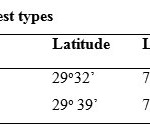 |
|
Sampling and Data Analysis
Vegetation analysis was done by using quadrat method15,14. The size of quadrat used for tree layer analysis was 10x10m. The sample size was one hectare forest, which was divided into four sub- sample plots of size 50x50 (2500m2). In each sub-sample plot, tree species were measured and categorized into different girth classes i.e. <10cm for seedlings, 10.1-30cm for saplings and ≥30.1 cm for trees. The girth of seedling and sapling was taken at 15 and 50cm from ground level respectively. The tree girth was measured at breast height i.e. 1.37 m from ground level. The regeneration of tree species in each forest was assessed as discussed and followed Shanker16. Tree species diversity of forest was determined by using Shannon-Weiner information index17.
Results
Tree Vegetation Analysis
Total 15 trees species were reported in studied forest sites. These numbers of species in each tree category consisted of viz., ShorearobustaGaertn.,TectonagrandisLinn., Cassia fistulaLinn.,Mallotusphilippensis(Lam.)Muell-Arg., Syzygiumcumini (L.) Skeels.,FicushispidaLinn,Holarrhenapubescens(Buch.- Ham.) wall, SchleichersoleosaLour., Randiadumetorum Retz., HolopteleaintergrifoliaRoxb., Haldinacordifolia (Roxb.)Ridsdale, AeglemarmelosL.,DalbergialanceolariaL.,GrewiaasiaticaL., and MangiferaindicaL. reported in both forest sites (Table.2)
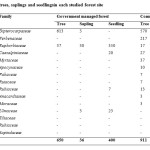 |
|
Total density of tree, sapling and seedling were 650,36 and 400 ind.ha-1 in government managed forest and 911, 1303 and 6656 ind. ha-1 for community managed (van panchayat) forest, respectively(Table 2).The species diversity for trees, saplings and seedlings was 0.313, 0.871 and 0.722 while concentration of dominance was 0.894, 0.674 and 0.772 respectively, in government managed forest. The species diversity was 1.681, 1.182 and 2.363 and concentration of dominance was 0.452, 0.670 and 0.291 in community managed forest,respectively (Table 3).
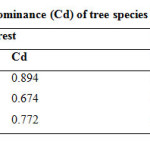 |
|
Regeneration of Tree Species
The relative proportions of seedlings, saplings, and trees of different size classes to the total density of tree species at each forest site were calculated to develop the population structure. In government managed forest tree species showed fair regeneration when was in order: Seedling >Sapling M. philippensis showed fair regeneration. The other tree species such as H. integrifolia,C. fistula and R. dumetorum were also reported in the studied forest (Fig.1). Sal was dominant and teak was co-dominant tree species in community managed forest. Where Sal showed reverse J-shape curve indicating good regeneration (seedling>sapling>tree)and teak showed fair regeneration while the other tree species also have showed fair regeneration(Fig.2).
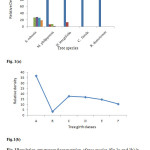 |
|
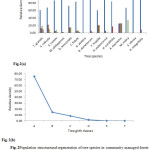 |
|
Discussion
In the Himalayan region, forest tree species composition and structure vary from lower to higher elevations due to varying soil and climatic conditions. Apart from these, the management and usufructs extraction methods used by foresters and village community people.In this study, the species diversity and regeneration results of government managed forests were not found satisfactory compared to community management forests because of large area of forests as well as higher density of tree species. However, diversity of species in each forest management system was on the lower side than forests studied in other parts of the region and elsewhere (table 4). It showed that forests in both management systems declined their species diversity that may be due to poor inputs of management and unsustainable use of usufructs from the forests.It is stated that forest dominated by individual one as in case of government management system, the tree density was on lower side than community management system having more number of species and density. So it is concluded that the forest that were managed by community having more density and diversity compared to the forest managed by government.
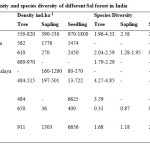 |
|
The regeneration and density of teak was similar to those have been reported for the same species by Carnevale and Monlagnii(2002) and Kaewkrom et al.,(2005)18,19. They also reported that the regeneration of teak tree species with regard to density was higher in mixed forest plantation than pure forest plantation.The seedlings, saplings and trees of a plant species exhibit the population dynamic which is used to decide their regeneration status20. There cruitment of seedlings was higher in Sal forests but its seedlings were unable to reach adult stage because of disturbances brought by frequent fire incidence,erosion of soil and water, uncontrolled grazing by nearby animals, cuttings of under canopy plant species by villagers for their domestic cattle. In case of teak, seedlings were higher but they are unable to reach sapling stage because of uprooting of seedlings for nursery use by the foresters and villagers. Besides this, the use of saplings for fuel and agriculture purposes by local people. According to Good and Good (1972)21 the soil nutrient, water and sunlight conditions may be the major factors for successful regeneration of tree species. Thus it is concluded that in mixed forests with more number of tree species possibly reduces the pressure on individual species which brought by local people for their use, therefore such forest comparatively received better time for their growth and development.
Acknowledgment
The first author is thankful to the University Grant Commission, New Delhi for providing the financial assistance under UGC-SAP (BSR) research fellowship.
References
- Lodhiyal, L.S., Lodhiyal, N., and Kapkoti, B., Structure and diversity of tree species in natural forests of Kumaun Himalaya in Uttarakhand. Journal of Plant Development Sciences,5(2): 97-105 (2013)
- Saxena, A.K., and Singh, J.S., Tree population structure of certain Himalayan forest associations and implications concerning their future composition. Vegetatio, 58:61-69(1984)
CrossRef - Singh, J.S., The biodiversity crisis: a multifaceted review. Current Science, 82: 638–647 (2002)
- Ram, J., Kumar, A., and Bhatt, J., Plant diversity in six forest types of Uttaranchal, Central Himalaya, India. Current Science, 86: 975-978 (2004)
- Champion, H.G., and Seth, S.K., Revised Survey ofthe Forest Types of India. Publication Division, Govt. of India, New Delhi ( 1968)
- Chauhan, D.S., Dhanai, C.S., Singh, B., Chauhan, S., Todaria, N.P., and Khalid, M.A., Regeneration and tree diversity in natural and planted forests in a Terai- Bhabhar forest in Katarniaghat Wildlife Sanctuary, India, Tropical Ecology, 49(1): 53-67 (2008)
- Singh, J.S., Sustainable development of the Indian Himalayan region: Linking ecological and economic concerns. Current science, 90(6): 784-788 (2006)
- Pitchairamu, C., Muthuchelian, K., and Siva, N., Floristic inventory and quantitative vegetation analysis of tropical dry deciduous forest in Piranmalai forest, Eastern Ghats, Tamilnadu, India. Ethnobotanical Leaflets, 12: 204-216 (2008)
- Sagar, R., and Singh, J.S., Structure, diversity, and regeneration of tropical dry deciduous forest of northern India. Biodiversity and Conservation, 14: 935-959 (2005)
CrossRef - Kadavvul, K. and Parthasarathy, N., Plant biodiversity and conservation of tropical semi-evergreen forests in the Shervarayan hills of Eastern Ghats, India. Biodiversity and Conservation, 8: 421-439 (1999)
- Kumar, Y., Floristic studies on Balphakram wildlife sanctuary in Meghalaya-5: rare, endemic or threatened flora. Journal of Meghalaya Science Society,11: 33-48 (1989)
- Kumar, M., Sharma, C.M., and Rajwar, G.S., A Study on Community Structure and Diversity of a Sub Tropical forest of Garhwal Himalaya. Indian Foresters,130(2): 207-214 (2004)
- Whittaker, R.H., Evolution and measurement of species diversity. Taxon,21: 213-251 (1975)
CrossRef - Saxena, A.K., and Singh, J.S., Quantitative profile structure of certain forest in the Kumaun Himalayan: Proceeding of the Indian Academy of Sciences, 91: 529-49 (1982)
- Misra, R., Ecology Work Book. Oxford and IBH Publishing Calcutta (1968)
- Shankar, U., A case study of high tree diversity in a Sal (Shorearobusta)-Dominated lowland forest of Eastern Himalaya: Floristic composition, regeneration and conservation. Current Science, 81: 776-786 (2001)
- Shannon, C., and Wiener, W., The mathematical Theory of communication (Urban: University of Illinois Press) (1963)
- Carnevale, N.J., and Montagnini, F., Facililating regeneration of secondary forests with the use of mixed and pure plantations of indigenous tree species. Forest Ecology and Management, 163:217-227 (2002)
CrossRef - Kaewkrom, P., Gajaseni, J., Jordan, and C.F., Gajaseni, N., Floristic regeneration in five types of teak plantations in Thailand. Forest Ecology and Management, 210: 351-361 (2005)
CrossRef - Teketay, D., Seedling populations and regeneration of woody species in dry Afromontane forests of Ethiopia. Forest Ecology and Management, 98: 149-165 (1997)
CrossRef - Good, N.F., and Good, R.E., Population dynamics of tree seedlings and saplings in mature Eastern hardwood forest. Bulletin of Torrey Botanical Club,99: 172-178 (1972)
CrossRef - Bohra, C.S., Lodhiyal, L.S., and Lodhiyal, N., Forest stands structure of Shiwalik region of Nainital district along an altitudinal gradient in India Central Himalaya. New York Science Journal, 3(12): 82-90 (2010)
- Sundriyal, R.C., Sharma, E., Rai, L.K., and Rai, S.C., Tree structure, regeneration and wood biomass removal in a Sub- Tropical forest of Mamlay watershed in the Sikkim Himalaya. Vegetatio, 113:53-63 (1994)
CrossRef - Pathak, G.C., Vegetation analysis and productivity of Shorearobusta F. and PinusroxburghiiSarg. In Kumaun Himalaya. Ph. D. thesis, KumaunUniversty. (2008)
- Mohanty, R.C., Mishra. R.K., Bal, S., and Upadhyay, V.P., Plant diversity assessment of Shorearobusta dominated forest stands of Similipal biosphere reserve. Journal of Indian Botanical Society, 84:21-29 (2005)
- Khera, N., Kumar, A., Ram, J., and Tewari, A., Plant biodiversity assessment in relation to disturbances in mid-elevational forest of Central Himalaya, India. Tropical Ecology,42(1): 83-95 (2001)







